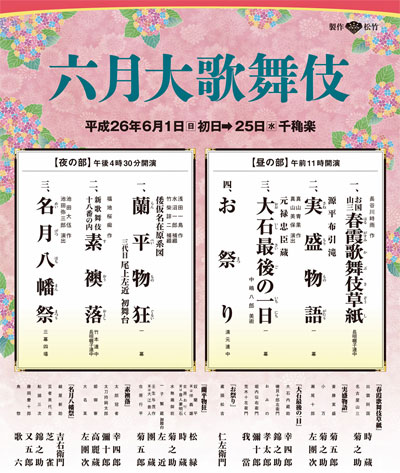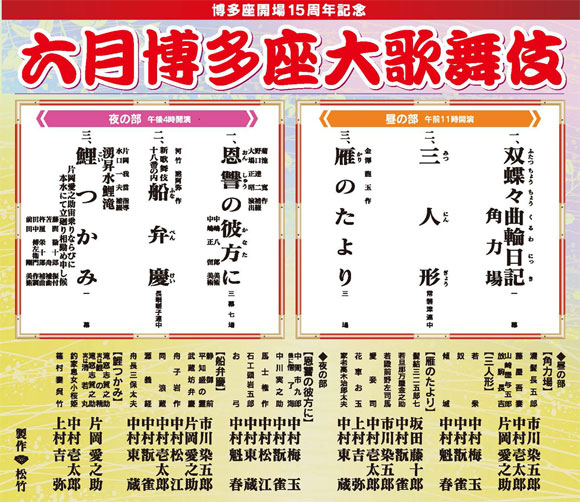| JUNE 2014 |
|
4 shows in T˘ky˘ (Kabukiza, National Theatre, Theatre Cocoon), 2 in Fukuoka (Hakataza), 2 shows in Ky˘to (Minamiza) and 1 tour (Central Provinces)!
|
| Kabukiza (T˘ky˘) |  |
| Dates | 1 ~ 25 June 2014 (Rokugatsu ďkabuki) June Grand Kabuki |
| MatinÚe |
Harugasumi Kabuki Z˘shi (Okuni Sanza) Genpei Nunobiki no Taki |
| Evening |
Yamatogana Ariwara Keizu Meigetsu Hachiman Matsuri |
| Casting |
Onoe Kikugor˘, Kataoka Nizaemon, Matsumoto K˘shir˘, Nakamura Kichiemon, Nakamura Tokiz˘, Onoe Kikunosuke, Nakamura Shibajaku, Kataoka Takatar˘, Kataoka Gat˘, Onoe Sh˘roku, Ichikawa Sadanji, Nakamura Kinnosuke, Band˘ Yajűr˘, Ichikawa Danz˘, Nakamura Matagor˘, Nakamura Karoku, Ichikawa Komaz˘, Onoe Sakon |
| Comments |
The son of Onoe Sh˘roku IV receives the name of Onoe Sakon III and makes his debut on stage (hatsubutai).
|
 |
|
|||
| Dates | 2 ~ 26 June 2014 (Rokugatsu Hakataza ďkabuki) June Hakataza Grand Kabuki |
||
| MatinÚe | |||
| Evening |
Onshű no Kanata-ni Waki Noboru Mizu-ni Koi Taki (Koi Tsukami) |
||
| Casting |
Sakata T˘jűr˘, Nakamura Kanjaku, Kataoka Ainosuke, Nakamura Baigyoku, Nakamura Kaishun, Ichikawa Somegor˘, Kamimura Kichiya, Nakamura T˘z˘, Nakamura Kazutar˘, Nakamura Matsue, Arashi Kitsusabur˘, Sawamura S˘nosuke, ďtani Hirotar˘ |
||
| Comments |
The Hakataza, the main theater in Fukuoka, celebrates the 15th anniversary of its opening with 2 Kabuki programs. The troupe is led by Living National Treasure Sakata T˘jűr˘.
|
||
 |
|
|||
| Dates | 6 ~ 28 June 2014 | ||
| Program | |||
| Casting |
Nakamura Kankur˘, Nakamura Shichinosuke, Onoe Matsuya, Kataoka Kamez˘, Band˘ Shingo, Nakamura Tsurumatsu, Sasano Takashi, Manako Keiji, ďmori Hiroshi, Oida Yoshi |
||
| Comments |
14th edition of the original Cocoon Kabuki performance, which recreates the atmosphere of the Edo koshibai and brings the actors closer to the audience. 4 actors are non-Kabuki actors!
|
||
 |
| National Theatre (T˘ky˘) |
| Dates | 2 ~ 24 June 2014 (Rokugatsu Kabuki Kansh˘ Ky˘shitsu) June Kabuki Appreciation Class |
| Program | |
| Casting |
Nakamura Hashinosuke, Nakamura Senjaku, Band˘ Kamesabur˘, Nakamura Kotar˘, Nakamura Toranosuke, Nakamura Kunio |
| Comments |
Educational program at the National Theatre called Kabuki Kansh˘ Ky˘shitu ('Kabuki Appreciation Class'). This is a very interesting formula for the beginners because there is lively presentation on stage of Kabuki or some aspects of the art like music, stage tricks or fighting scenes. It is followed by the drama "Jiisan Baasan".
|
| Kabuki Tour in the central provinces | |
| Dates | 31 May ~ 27 June 2014 (Sh˘chiku ďkabuki) Sh˘chiku Grand Kabuki |
| Program | |
| Casting |
Ichikawa Ennosuke, Ichikawa Chűsha, Kataoka Hidetar˘, Band˘ Takesabur˘, Ichikawa Ukon, Ichikawa Emisabur˘, Ichikawa Emiya, Ichikawa Tsukinosuke, Ichikawa En'ya, Ichikawa K˘tar˘, Ichikawa Juen, Ichikawa Enshir˘ |
| Comments |
Ichikawa Ennosuke IV and Ichikawa Chűsha IX celebrate their shűmei touring in the central provinces!
|
|
|||
| Dates | 5 ~ 12 June 2014 (Band˘ Tamasabur˘ Tokubetsu K˘en) Band˘ Tamasabur˘ Special Performances |
||
| Program |
Chifuijin Tanj˘ H˘rai nu Shima |
||
| Casting |
Band˘ Tamasabur˘, Tamagusuku Seigi, Kawamitsu K˘ta |
||
| Comments |
Collaboration of the highest quality between the traditional art in Okinawa which prospered uniquely as Ryűkyű Islands and Living National Treasure Band˘ Tamasabur˘. He will share the stage with two young and talented Okinawa Kumi Odori dancers, Tamagusuku Seigi and Kawamitsu K˘ta.
|
||
| Dates | 15 ~ 21 June 2014 (Band˘ Tamasabur˘ Tokubetsu K˘en) Band˘ Tamasabur˘ Special Performances |
||
| Program |
Kosunoto Kurokami Kane-ga-Misaki |
||
| Casting | |||
| Comments |
Three traditional Jiutamai dances by a Living National Treasure Band˘ Tamasabur˘ which show his attractive elegance.
|
||
|
|
| Contact | Main | Top | Updates | Actors | Plays | Playwrights | Programs | Links | FAQ | Glossary | Chronology | Illustrations | Prints | Characters | Derivatives | Theaters | Coming soon | News |

